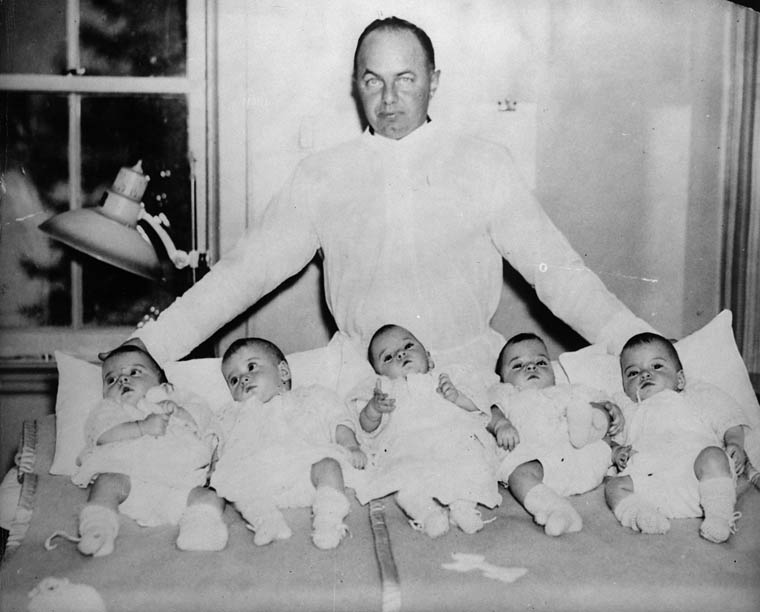 |
| They made the cover of Time. I told you they were a big deal. |
There were five, so... it's inherently not unique. Really freaking rare, yes, and I guess if you judge them as one entity... ah, whatever.
Having quintuplets is kind of like winning the lottery, except the prize is crippling financial debt in place of extreme, sudden wealth. Having them born all the same gender is like also winning some sort of bonus "play again for free!" prize at the bottom of the same ticket. Having them all survive is like taking your replay and winning all over again. The statistics on this really are mind boggling; at the time the book was written (1970-something) there had been only a handful of cases of this kind of birth in recorded history. A quick wikipedia search shows a lengthy list of multiple births which would seemingly nullify the idea that this is such an anomaly, but note the dates - they're almost exclusively after 1960, the vast majority being post-1970. The reason is fertility drugs really messed with nature, so these births are considerably more common. The Dionne Quintuplets? They were well before - 1934 to be exact.
Then there's the fact that they survived. These babies were so shockingly tiny that the altruistic work-for-often-nothing country physician, one Dr. Dafoe, that delivered them described them as "rats" in the media due to how inhuman their size was. Immediately they were put under incredibly intensive care; a change of only a few degrees would cause their lips to turn blue or their cheeks to flush, and in such a fragile infant, that could very easily spell death. They were miracle babies, through and through, but what happened afterwards is where the story goes from a stoke of incredible chance to absolutely bizarre. And kind of tragic. There's a touch of tragic in there.
Meanwhile, their fame rose. Dolls were made with their likeness, they endorsed products, and all the while having thousands stream through the "human zoo". Their height was, oddly enough, during the depression, and they served as a message of hope and good news amongst frequently nothing but bad. People would leave their viewing with tears streaming down their eyes, apparently quite easily moved as they were born before the days of television. Their main doctor became one of the most well known general practitioners in the world. Honestly, they were about as big of a celebrity as you could be in that time. They were everywhere.
At the age of eighteen, they were returned to their parents. This was where I expected the book to take a turn for the better (the name of the book being The Dionne Years: A Thirties Melodrama) but if anything it got considerably worse. They had a terrible relationship with their parents, understandably as they would surely have no social skills whatsoever. The father was incredibly protective and stifled the girls, but he had no real choice in the matter; they needed protection. When the girls would go out together, and they typically would as they were all they knew, they would be ogled (but not in the stereotypical construction worker way when he sees a woman pass by on the street) and stared at, which didn't help the fact that the girls were, understandably again, tremendously shy. Eventually they separated almost entirely from their parents.
 |
| Here they are a little older, where you can see that they really are identical and not just similar looking babies. |
The first quintuplet too pass away, Emilie, died in her twenties. She had a condition that caused the occasional seizure, which required her to be under constant supervision. She was working in a nunnery at the time, and when the nun she was with went to mass she had one of these episodes and all alone she died suffocated by her pillow. Marie died of a blood clot during a heavy episode of drinking, as she was in a terrible mental state. Yvonne, the eldest, passed away from cancer in her sixties. The two remaining survivors live together still.
I can't tell what this story is meant to be. It began as a miracle turned world-wide sensation. Then somewhere along the way it became messy, fuelled with greed, and ultimately disastrous. The result was five girls incapable of living a normal life after having seen nothing of the sort. Regardless, I put their story in this blog because it was a major event of the 1930s in North America. Plus, it was really freaking interesting, for good or for bad.
The Dionne Quintuplets were often told they would form a relatively effective indoor soccer lineup if they could find a proper keeper.
Famous Historical Figures Say the Darndest Things!
- It's a shame I returned the book to the library as it was riddled with interesting quotations. I snagged this one from CBC's website, and it's the best I can do. The government said they would care for "all their normal needs for the rest of their lives." I just have to wonder what they would consider to be normal.

Very, very interesting! It's nice to see what they looked like after they were just babies. Thank you for the education and the enjoyable read! :-)
ReplyDelete